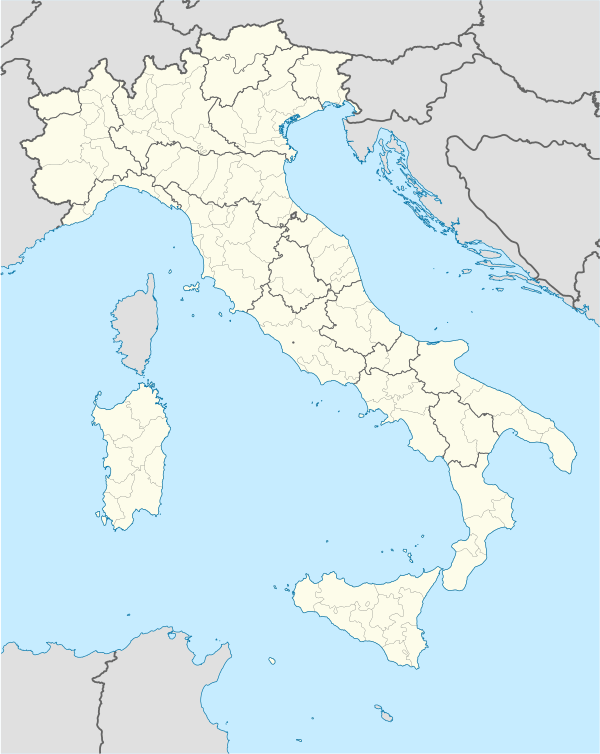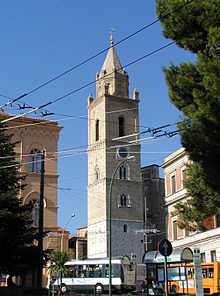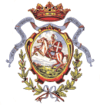Chieti
| Chieti | |||
|---|---|---|---|
| Comune | |||
| Città di Chieti | |||
|
Panorama of Chieti | |||
| |||
 Chieti Location of Chieti in Italy | |||
| Coordinates: 42°21′N 14°10′E / 42.350°N 14.167°E | |||
| Country | Italy | ||
| Region | Abruzzo | ||
| Province | Chieti (CH) | ||
| Frazioni | Bascelli, Brecciarola, Buonconsiglio-Fontanella, Carabba, Cerratina, Chieti Scalo, Colle dell'ara, Colle Marcone, Crocifisso, De Laurentis Vallelunga, Filippone, Fonte Cruciani, Iachini, La Torre, Madonna del Freddo, Madonna della Vittoria, Madonna delle Piane, San Martino, San Salvatore, Santa Filomena, Selvaiezzi, Tricalle, Vacrone Cascini, Vacrone Colle San Paolo, Vacrone Villa Cisterna, Vallepara, Villa Obletter, Villa Reale | ||
| Government | |||
| • Mayor | Umberto Di Primio | ||
| Area | |||
| • Total | 58.55 km2 (22.61 sq mi) | ||
| Elevation | 330 m (1,080 ft) | ||
| Population (November 2012)[1] | |||
| • Total | 51,340 | ||
| • Density | 880/km2 (2,300/sq mi) | ||
| Demonym | Teatini | ||
| Time zone | CET (UTC+1) | ||
| • Summer (DST) | CEST (UTC+2) | ||
| Postal code | 66100 | ||
| Dialing code | 0871 | ||
| Patron saint | St. Justin of Chieti | ||
| Saint day | May 11 | ||
| Website | Official website | ||
Chieti (Italian: [ˈkjeːti]; Greek: Θεάτη; Latin: Theate, Teate) is a city and comune in Southern Italy, 200 kilometres (124 miles) east by northeast of Rome. It is the capital of the province of Chieti in the Abruzzo region. Chieti lies on a crest along the Pescara River a few kilometres away from the Adriatic Sea, and with the Maiella and Gran Sasso mountains in the background.
History
Chieti is amongst the most ancient of Italian cities. According to mythological legends, the city was founded in 1181 B.C. by the Homeric Greek hero Achilles and was named in honor of his mother, Thetis. It was called Theate (Greek: Θεάτη) (or Teate in Latin). As Theate Marrucinorum, Chieti was the chief town of the warlike Marrucini. According to Strabo, it was founded by the Arcadians as Thegeate (Θηγεάτη).
After the Marrucini were defeated by the Romans, they became loyal allies of the more powerful forces. Their territory was placed under Roman municipal jurisdiction after the Social War. In imperial times, Chieti's population reached 60,000 inhabitants but, after the fall of the Western Roman Empire, it was destroyed by Visigoths and Heruli. Later it was seat of a gastaldate under the Lombard kings. After its destruction by Peppin, it became a fief of the Duchy of Benevento.
Chieti recovered some political and economic importance under the Norman rule of Southern Italy, a role it kept also under the Hohenstaufen, Angevine and Aragonese rulers. After a cultural and architectural flourishing during the 17th century, under the aegis of the Counter-Reformation, Chieti was decimated by fatalities from plague in 1656. In the 18th century, several new academies and schools were developed here, which contributed to the city's artistic heritage. In 1806 Chieti was turned into a fortress by Napoleon's France. In 1860 it became part of the newly created Kingdom of Italy.
During World War II, Chieti was declared an open city (like Rome) and was not bombed by either side. The city at this time welcomed many refugees from the near towns and villages. Allied forces liberated the city on June 9, 1944, one day after the Germans left the city.
Main sights

- The Gothic Cathedral, re-built by bishop Attone I in 1069. Of that building only parts of the Romanesque crypt remain. The church was remade in the 14th century and the bell tower was enlarged. After several earthquakes, the church was rebuilt again in the late 17th-18th centuries in Baroque style.
- Oratory of Sacro Monte dei Morti
- Church of San Francesco al Corso, founded in 1239. The façade shows an incomplete Baroque restoration.
- Church of Santa Chiara.

in the National Archeological Museum of Abruzzo in Chieti]]
Under the church of SS. Pietro e Paolo and the adjoining houses are extensive substructures (in opus reticulatum and brickwork) of the 1st century CE, belonging to a building erected by M. Vectius Marcellus[2] and Helvidia Priscilla. There are also remains of large reservoirs and of an ancient theatre. In the early 21st century, new archeological excavations are under way on the site of the former Campo Sportivo.
Museums
- National Archaeological Museum of the Abruzzi, "Villa Frigerj" - The rooms of the museum are dedicated to: Burial cults in pre-Roman Abruzzo / Italic sculpture / The Capestrano Warrior / The Pansa collection / The Sanctuary of Hercules Curinus at Sulmona / The Numismatic collection / Roman Iconography in Abruzzo.
- Art Museum - "Costantino Barbella"
- Biomedical Science Museum (Paleopathology and Bioarchaeology)
- Archaeological Museum, "La Civitella"
- Diocesan Theatine Museum
- Art Museum, "Palazzo de Mayo"
Education
The University of Chieti (Università G. d'Annunzio - Chieti e Pescara) is based in Chieti and Pescara and hosts about 35,000 students, covering areas of Architecture, Arts and Philosophy, Economics, Foreign Languages and Literatures, Management, Medicine, Pharmacy, Psychology, Sciences, Social Sciences and Sports Medicine.
Climate
Chieti climate is considered genuine Mediterranean. It presents high humidity all year round, with rainy/snowy and quite cold winters and hot and dry summers. Rain is a common event, especially during fall and spring, with accumulations of around 600 to 700 millimetres (24 to 28 in) a year. Snowfall is consistent during winter, with temperatures that often drop below 0 °C (32 °F) during winter nights. Fog is a common event during fall and winter, due to very high humidity in these seasons. Wind from the north-east (from the Adriatic sea) carries cold from Eurasian Steppe, while wind from south-west (from the Tyrrhenian Sea) carries hot from Algerian Desert. Wind is quite present during year.
| Climate data for Chieti, at the University | |||||||||||||
|---|---|---|---|---|---|---|---|---|---|---|---|---|---|
| Month | Jan | Feb | Mar | Apr | May | Jun | Jul | Aug | Sep | Oct | Nov | Dec | Year |
| Record high °C (°F) | 21.6 (70.9) |
26.5 (79.7) |
28.1 (82.6) |
29.3 (84.7) |
35.1 (95.2) |
37.5 (99.5) |
39.3 (102.7) |
41.7 (107.1) |
37.9 (100.2) |
29.7 (85.5) |
27.6 (81.7) |
24.8 (76.6) |
41.7 (107.1) |
| Average high °C (°F) | 11.9 (53.4) |
12.3 (54.1) |
16.0 (60.8) |
19.7 (67.5) |
23.8 (74.8) |
28.5 (83.3) |
31.3 (88.3) |
31.8 (89.2) |
26.9 (80.4) |
21.3 (70.3) |
17.3 (63.1) |
12.9 (55.2) |
21.1 (70) |
| Daily mean °C (°F) | 7.9 (46.2) |
8.1 (46.6) |
11.4 (52.5) |
14.8 (58.6) |
18.6 (65.5) |
22.9 (73.2) |
25.7 (78.3) |
25.7 (78.3) |
21.7 (71.1) |
16.8 (62.2) |
13.1 (55.6) |
8.8 (47.8) |
16.2 (61.2) |
| Average low °C (°F) | 4.0 (39.2) |
4.0 (39.2) |
6.8 (44.2) |
10.0 (50) |
13.4 (56.1) |
17.4 (63.3) |
20.1 (68.2) |
19.7 (67.5) |
16.5 (61.7) |
12.3 (54.1) |
9.0 (48.2) |
4.8 (40.6) |
11.5 (52.7) |
| Record low °C (°F) | −1.5 (29.3) |
−3.9 (25) |
−2.7 (27.1) |
0.9 (33.6) |
6.3 (43.3) |
9.3 (48.7) |
13.4 (56.1) |
11.5 (52.7) |
7.9 (46.2) |
3.1 (37.6) |
0.4 (32.7) |
−5.3 (22.5) |
−5.3 (22.5) |
| Average precipitation mm (inches) | 59.2 (2.331) |
59.1 (2.327) |
61.9 (2.437) |
57.2 (2.252) |
61.4 (2.417) |
43.8 (1.724) |
45.3 (1.783) |
11.4 (0.449) |
79.3 (3.122) |
61.5 (2.421) |
70.0 (2.756) |
56.4 (2.22) |
666.5 (26.24) |
| Avg. precipitation days (≥ 1.0 mm) | 8.7 | 8.5 | 7.8 | 8.1 | 8.1 | 4.8 | 3.6 | 2.6 | 6.3 | 7.3 | 7.5 | 8.0 | 81.3 |
| Average relative humidity (%) | 77.9 | 73.4 | 70.2 | 70.9 | 66.4 | 64.3 | 60.3 | 62.5 | 70.6 | 78.6 | 79.7 | 74.2 | 70.7 |
| Source: Chieti Meteo[3] | |||||||||||||
Famous people
- Gaius Asinius Pollio (75 BC / AD 4) - Roman soldier, politician, orator, poet, playwright, literary critic and historian
- Severino Di Giovanni - Anarchist who exiled himself to Argentina in 1922
- Ferdinando Galiani - Economist
- Sergio Marchionne - Businessman and CEO of FIAT S.p.A. and Chrysler
- Alessandro Valignano - Jesuit missionary who helped the introduction of Catholicism to the Far East
- Pierluigi Zappacosta - Co-founder of Logitech, Venture Partner with Noventi, President/CEO of Sierra Sciences
See also
References
Sources
 This article incorporates text from a publication now in the public domain: Chisholm, Hugh, ed. (1911). Encyclopædia Britannica (11th ed.). Cambridge University Press.
This article incorporates text from a publication now in the public domain: Chisholm, Hugh, ed. (1911). Encyclopædia Britannica (11th ed.). Cambridge University Press.
External links
| Wikimedia Commons has media related to Chieti. |
- Site of National Museum Archaeological of Abruzzi Villa Frigerii
- Official site of Biomedical Museum
- Official site of Archaeological Museum "La Civitella"
- Official site of Art Museum "Costantino Barbella"
- Italy's most important Easter Procession in Chieti
- Photo Gallery (Italian)
.jpg)

